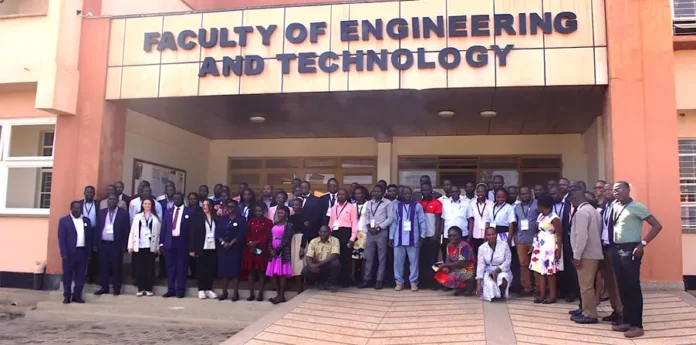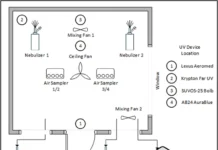By Prof. Hadas Mamane, faculty of Engineering, Tel Aviv University and co-Europe-Middle East-Africa region (EMEA) regional vice president;
Dr. Moses Egor, senior lecturer of Chemistry, Busitema University, Uganda; and Marion Mugusu, IUVA young professional, MSc in Science
in Physics, Egerton, Kenya
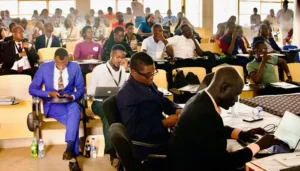 The first-ever workshop on ultraviolet (UV) water treatment technologies in Uganda – and all of Africa – took place on January 23, 2025, at Busitema University in Tororo, Uganda. This event brought together researchers, professionals and innovators united by a shared goal: advancing sustainable, safe water solutions for the future. The conference saw an impressive 152 participants in attendance. Among the notable guests were Prof. Paul Waako, vice chancellor of Busitema University; Prof. Saphina Biira, first deputy vice chancellor (Academic Affairs); and Dr. Lillian Nabasa Gimuguni, academic registrar. Also present were directors, deans, heads of departments and representative teaching staff. More than 100 graduate students participated, including those from neighboring universities, such as Mbarara University of Science and Technology, Muni University, Kabale University and Mountains of the Moon University (all in Uganda), as well as Egerton University and Kisii University in Kenya.
The first-ever workshop on ultraviolet (UV) water treatment technologies in Uganda – and all of Africa – took place on January 23, 2025, at Busitema University in Tororo, Uganda. This event brought together researchers, professionals and innovators united by a shared goal: advancing sustainable, safe water solutions for the future. The conference saw an impressive 152 participants in attendance. Among the notable guests were Prof. Paul Waako, vice chancellor of Busitema University; Prof. Saphina Biira, first deputy vice chancellor (Academic Affairs); and Dr. Lillian Nabasa Gimuguni, academic registrar. Also present were directors, deans, heads of departments and representative teaching staff. More than 100 graduate students participated, including those from neighboring universities, such as Mbarara University of Science and Technology, Muni University, Kabale University and Mountains of the Moon University (all in Uganda), as well as Egerton University and Kisii University in Kenya.
Water Situation in Uganda
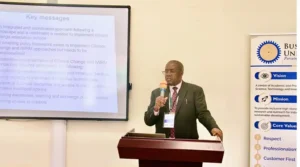 Despite Uganda’s abundant freshwater resources, access to safe drinking water remains a major challenge, mirroring issues faced across sub-Saharan Africa. Of the country’s 47 million people, an estimated 37 million (81%) lack reliable access to clean water, particularly in rural areas, where long distances must be traveled to collect it (UNICEF Uganda). This water crisis has far-reaching consequences, affecting education, reinforcing cycles of poverty and fueling the spread of waterborne diseases like typhoid, increasing medical costs and reducing productivity. Poor sanitation exacerbates the problem – nearly 10% of Ugandans practice open defecation, contributing to the spread of diarrheal diseases, a leading cause of child mortality (Water.org).
Despite Uganda’s abundant freshwater resources, access to safe drinking water remains a major challenge, mirroring issues faced across sub-Saharan Africa. Of the country’s 47 million people, an estimated 37 million (81%) lack reliable access to clean water, particularly in rural areas, where long distances must be traveled to collect it (UNICEF Uganda). This water crisis has far-reaching consequences, affecting education, reinforcing cycles of poverty and fueling the spread of waterborne diseases like typhoid, increasing medical costs and reducing productivity. Poor sanitation exacerbates the problem – nearly 10% of Ugandans practice open defecation, contributing to the spread of diarrheal diseases, a leading cause of child mortality (Water.org).
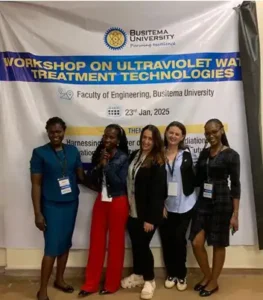 Uganda’s primary drinking water source is groundwater, supplying over 80% of potable water, especially in rural areas. However, water quality varies. Many urban slum residents rely on springs and boreholes, as piped water remains costly. While most groundwater is potable, some regions face issues like salinity, acidity and contamination from poor sanitation. Fecal coliforms and elevated nitrate levels, often linked to deep pit latrines, pose serious health risks. Additionally, contaminants like fluoride, iron and manganese create further challenges. Fluoride contamination, exceeding the WHO guideline of 1.5 mg/L, is particularly concerning in the Rift Valley and volcanic regions.
Uganda’s primary drinking water source is groundwater, supplying over 80% of potable water, especially in rural areas. However, water quality varies. Many urban slum residents rely on springs and boreholes, as piped water remains costly. While most groundwater is potable, some regions face issues like salinity, acidity and contamination from poor sanitation. Fecal coliforms and elevated nitrate levels, often linked to deep pit latrines, pose serious health risks. Additionally, contaminants like fluoride, iron and manganese create further challenges. Fluoride contamination, exceeding the WHO guideline of 1.5 mg/L, is particularly concerning in the Rift Valley and volcanic regions.
Workshop in Uganda
 The workshop featured in-depth discussions on UV-based water purification technologies, their advancements, challenges and role in water quality management, particularly in the face of climate change. Participants engaged in insightful presentations, case studies and sessions, exploring the science behind UV technology and its application in water treatment. The latest innovations driving the adoption of UV purification also were thoroughly examined.
The workshop featured in-depth discussions on UV-based water purification technologies, their advancements, challenges and role in water quality management, particularly in the face of climate change. Participants engaged in insightful presentations, case studies and sessions, exploring the science behind UV technology and its application in water treatment. The latest innovations driving the adoption of UV purification also were thoroughly examined.
 The keynote lecture was delivered by Dr. Callist Tindimugaya, commissioner for Water Resources Planning and Regulation at Uganda’s Ministry of Water and Environment. He addressed the challenges of climate change and its impact on Uganda’s water resources, emphasizing Africa’s vulnerability due to poverty, weak institutional capacity and rapid population growth. Dr. Tindimugaya stressed the urgency of integrated water resources management and the need for collaboration among stakeholders, including academia, to develop sustainable solutions. He also shared practical strategies for tackling water scarcity, such as restoring wetlands and constructing dams to improve water availability.
The keynote lecture was delivered by Dr. Callist Tindimugaya, commissioner for Water Resources Planning and Regulation at Uganda’s Ministry of Water and Environment. He addressed the challenges of climate change and its impact on Uganda’s water resources, emphasizing Africa’s vulnerability due to poverty, weak institutional capacity and rapid population growth. Dr. Tindimugaya stressed the urgency of integrated water resources management and the need for collaboration among stakeholders, including academia, to develop sustainable solutions. He also shared practical strategies for tackling water scarcity, such as restoring wetlands and constructing dams to improve water availability.
Another keynote lecture was delivered by Prof. Hadas Mamane, who provided an overview of UV disinfection, including its fundamental principles, key terminology and applications in water treatment. She showcased her collaborative work with Dr. Dana Pousty and the NGO Innovation Africa on implementing community-based UV LED technology in low-income communities. The third keynote lecture was delivered by Prof. Thalappil Pradeep from the Indian Institute of Technology Madras, who focused on affordable and clean water solutions using advanced nanomaterials. Prof. Pradeep highlighted the development of a bio-nanocomposite filter capable of removing arsenic from groundwater at an extremely low cost. He emphasized the transformative potential of nanotechnology in providing effective and affordable water purification solutions and showcased how these innovations already have been scaled up to benefit over 1.4 million people across India.
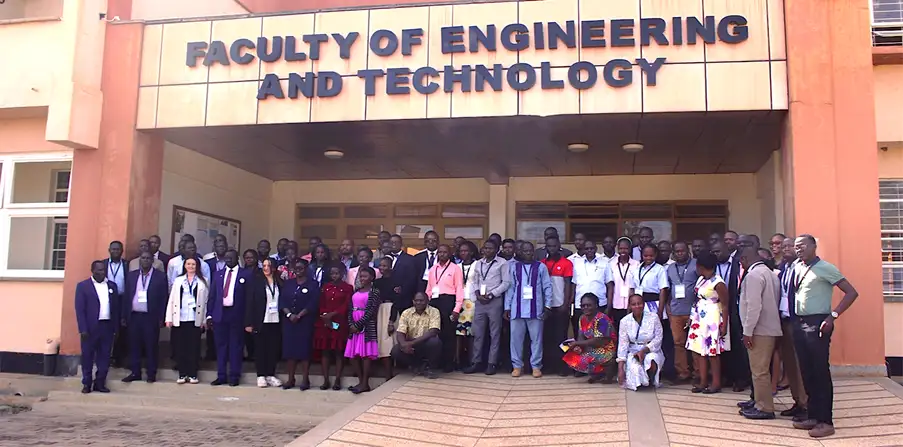 As part of an interactive session, students and faculty were asked to bring drinking water samples from their homes or communities and conduct a simple survey on water usage and quality. During her talk on People’s Water Data, Suzan Kagan, a Ph.D. student at Tel Aviv University and coordinator of an international hybrid course on water quality, invited participants to present their samples. She then conducted key water quality tests, including pH, conductivity, turbidity and E. coli, as well as total coliform analysis. In addition to demonstrating these tests, she emphasized the importance of community-driven water monitoring and the role of local water quality data in improving access to safe drinking water.
As part of an interactive session, students and faculty were asked to bring drinking water samples from their homes or communities and conduct a simple survey on water usage and quality. During her talk on People’s Water Data, Suzan Kagan, a Ph.D. student at Tel Aviv University and coordinator of an international hybrid course on water quality, invited participants to present their samples. She then conducted key water quality tests, including pH, conductivity, turbidity and E. coli, as well as total coliform analysis. In addition to demonstrating these tests, she emphasized the importance of community-driven water monitoring and the role of local water quality data in improving access to safe drinking water.
The workshop featured short research presentations on water quality assessments, UV degradation mechanisms for pollutants and the use of solar energy to power UV LEDs for water treatment. Marion Mogusu, a Master’s student at Egerton University, and a member of the IUVA’s Young Professionals (YP) group spoke about the importance of YP engagement and encouraged interested students to join. She also proposed the formation of an East African YP group to help expand professional networks, promote research and facilitate knowledge-sharing among UV researchers and practitioners in the region.
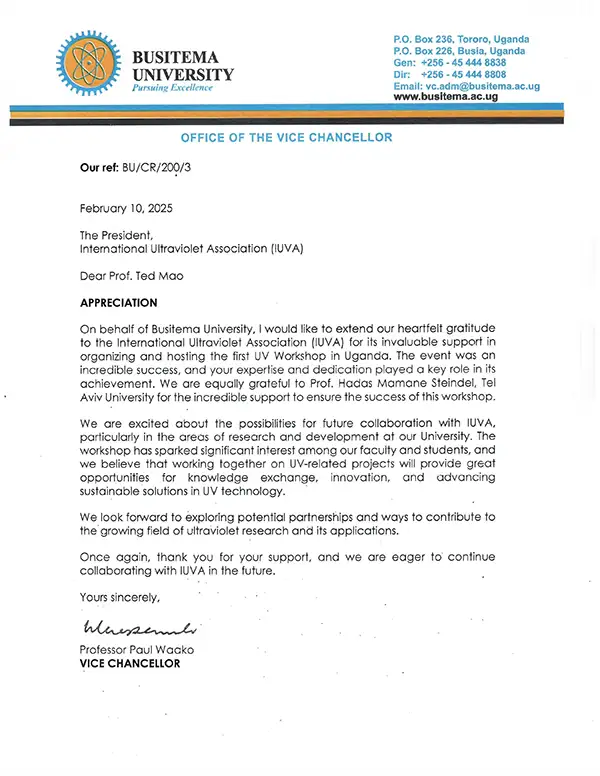 The workshop concluded with a short presentation from Dr. Moses Egor. He highlighted advancements in nanomaterials for water purification, focusing on solutions for fluoride contamination. Additionally, he discussed the development of a sensor using luminescent metal clusters protected by carborane derivatives, designed for detecting water pollutants. Dr. Egor expressed gratitude to all sponsors and recognized IUVA President Ted Mao and Comwin for their significant contributions to the conference.
The workshop concluded with a short presentation from Dr. Moses Egor. He highlighted advancements in nanomaterials for water purification, focusing on solutions for fluoride contamination. Additionally, he discussed the development of a sensor using luminescent metal clusters protected by carborane derivatives, designed for detecting water pollutants. Dr. Egor expressed gratitude to all sponsors and recognized IUVA President Ted Mao and Comwin for their significant contributions to the conference.


